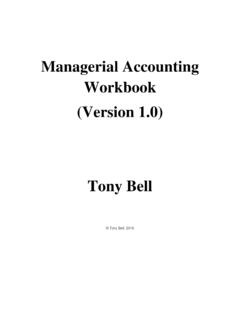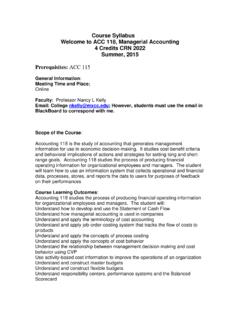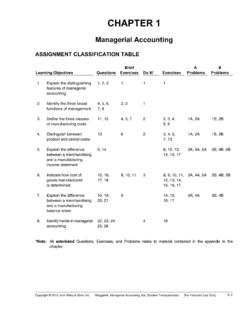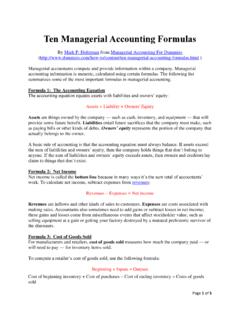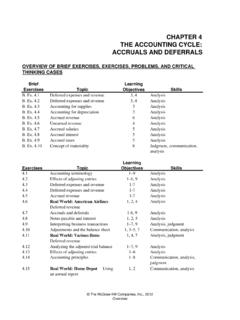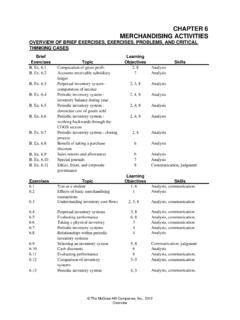Transcription of 15th Edition Financial & Managerial Accounting - GBV
1 15th EditionFinancial &ManagerialAccountingTHE BASIS FOR BUSINESS DECISIONSJan R. WilliamsUniversity of TennesseeSusan F. HakaMichigan State UniversityMark S. BettnerBucknell UniversityJoseph V. CarcelioUniversity of TennesseeMcGraw-HillIrwinBoston Burr Ridge, IL Dubuque, IA New York San Francisco St. LouisBangkok Bogota Caracas Kuala Lumpur Lisbon London Madrid Mexico CityMilan Montreal New Delhi Santiago Seoul Singapore Sydney Taipei TorontoContentsAccounting: Informationfor Decision MakingAccounting Information: A Means to an End 4 Accounting from a User's Perspective 4 Types of Accounting Information 5 Accounting Systems 6 Determining Information Needs 7 The Cost of Producing Accounting Information 7 Basic Functions of an Accounting System 7 Who Designs and Installs Accounting Systems?
2 8 Components of Internal Control 8 Financial Accounting Information 9 External Users of Accounting Information 9 Objectives of External Financial Reporting 10 Characteristics of Externally Reported Information 12 Management Accounting Information 13 Users of Internal Accounting Information 13 Objectives of Management Accounting Information 14 Characteristics of ManagementAccounting Information 15 Integrity of Accounting Information 16 Institutional Features 17 Professional Organizations 19 Competence, Judgment, and Ethical Behavior 21 Careers in Accounting 23 Public Accounting 23 Management Accounting 24 Governmental Accounting 24 Accounting Education 24 What about Bookkeeping?
3 25 Accounting as a Stepping-Stone 25 But What about Me? I'm Not an Accounting Major 25 Ethics^ Fraud & Corporate Governance . 26 Concluding Remarks 26 End-of-Chapter Review 27 Assignment Material 30 Basic FinancialStatementsIntroduction to Financial Statements 40A Starting Point: Statement of Financial Position 41 Assets 42 Liabilities 44 Owners' EquityThe Accounting EquationThe Effects of Business Transactions.
4 An IllustrationEffects of These Business Transactionson the Accounting EquationIncome StatementStatement of Cash FlowsRelationships among Financial StatementsFinancial Analysis and Decision MakingForms of Business OrganizationSole ProprietorshipsPartnershipsCorporationsR eporting Ownership Equity in theStatement of Financial PositionThe Use of Financial Statements byExternal PartiesThe Need for Adequate DisclosureManagement's Interest in Financial StatementsEthics, Fraud & Corporate GovernanceConcluding RemarksEnd-of-Chapter ReviewAssignment Material45454650515354575757585858596060 61626366 The Accounting Cycle:Capturing EconomicEventsThe Accounting CycleThe Role of Accounting RecordsThe LedgerThe Use of AccountsDebit and Credit EntriesDouble-Entry Accounting The Equality ofDebits and CreditsThe JournalPosting Journal Entries to the Ledger Accounts(and How to "Read" a Journal Entry)Recording Balance Sheet Transactions:An IllustrationLedger Accounts after PostingWhat Is Net Income?
5 Retained EarningsThe Income Statement: A PreviewRevenue89899091929296989898100 ExpensesThe Accrual Basis of AccountingDebit and Credit Rules for Revenue and ExpensesDividendsRecording Income Statement Transactions:An IllustrationThe JournalFebruary's Ledger BalancesThe Trial BalanceUses and Limitations of the Trial BalanceEthics, Fraud & Corporate GovernanceConcluding RemarksThe Accounting Cycle in PerspectiveEnd-of-Chapter ReviewAssignment Material10010210210310310910911111211211 3113114119 The Accounting Cycle:Accruals and DeferralsAdjusting EntriesThe Need for Adjusting EntriesTypes of Adjusting EntriesAdjusting Entries and Timing DifferencesCharacteristics of Adjusting EntriesYear-End at Overnight Auto ServiceConverting Assets to ExpensesThe Concept of DepreciationConverting Liabilities to RevenueAccruing Unpaid ExpensesAccruing Uncollected RevenueAccruing Income Taxes Expense:The Final Adjusting EntryAdjusting Entries and Accounting PrinciplesThe Concept of MaterialityEffects of the Adjusting EntriesEthics, Fraud & Corporate GovernanceConcluding RemarksEnd-of-Chapter ReviewAssignment Material14214214214314414514614815115215 4155156157158161161162167 The Accounting Cycle.
6 Reporting FinancialResultsPreparing Financial StatementsThe Income StatementThe Statement of Retained EarningsThe Balance Sheet194194197197 Relationships among the Financial StatementsDrafting the Notes That Accompany Financial StatementsWhat Types of Information Must Be Disclosed?Closing the Temporary AccountsClosing Entries for Revenue AccountsClosing Entries for Expense AccountsClosing the Income Summary AccountClosing the Dividends AccountSummary of the Closing ProcessAfter-Closing Trial BalanceA Last Look at Overnight: Was 2009 a Good Year? Financial Analysis and Decision Making "Preparing Financial Statements Covering DifferentPeriods of TimeEthics, Fraud & Corporate GovernanceConcluding RemarksSupplemental Topic: The WorksheetIsn't This Really a Spreadsheet?
7 How Is a Worksheet Used?The Mechanics: How It's DoneWhat If: A Special Application of Worksheet SoftwareEnd-of-Chapter ReviewAssignment Material19819819920020120120220320420520 5206208209209210210210210213214218 Susquehanna Equipmental Rentals 2446 MerchandisingActivitiesMerchandising Companies 248 The Operating Cycle of a Merchandising Company 248 Income Statement of a Merchandising Company 249 Accounting System Requirements for MerchandisingCompanies 250 Two Approaches Used in Accounting for MerchandiseInventories 251 Perpetual Inventory Systems 251 Taking a Physical
8 Inventory 253 Closing Entries in a Perpetual Inventory System 254 Periodic Inventory Systems 254 Operation of a Periodic Inventory System 254 Closing Process in a Periodic Inventory System 255 Comparison of Perpetual and Periodic Inventory Systems 257 Selecting an Inventory System 258 Transactions Relating to Purchases 259 Credit Terms and Cash Discounts 259 Returns of Unsatisfactory Merchandise 261 Transportation Costs on Purchases 261 XXIVT ransactions Relating to Sales 262 Sales Returns and Allowances 262 Sales Discounts 263 Delivery Expenses 263 Accounting for Sales Taxes 264 Modifying an Accounting System 264 Special Journals Provide Speed and Efficiency 264 Financial Analysis and Decision Making 265 Net Sales 265 Gross Profit Margins 265 Ethics.
9 Fraud & Corporate Governance 267 Concluding Remarks 267 End-of-Chapter Review 268 Assignment Material 2727 Financial AssetsHow Much Cash Should a Business Have? 292 The Valuation of Financial Assets 292 Cash 293 Reporting Cash in the Balance Sheet 293 The Statement of Cash Flows '; 294 Cash Management / 294 Internal Control over Cash 294 Bank Statements 295 Reconciling the Bank Statement 295 Petty Cash Funds 299 Short-Term Investments 299 Accounting for Marketable Securities 300 Purchase of Marketable Securities 300 Recognition of Investment Revenue 301 Sale of Investments
10 301 Adjusting Marketable Securities to Market Value 302 Accounts Receivable 303 Uncollectible Accounts 303 The Allowance for Doubtful Accounts 305 Writing Off an Uncollectible Account Receivable 305 Monthly Estimates of Credit Losses 306 Concentrations of Credit Risk 308 Recovery of an Account Receivable Previously Written Off 308 Direct Write-Off Method 309 Internal Controls for Receivables 310 Management of Accounts Receivable 310 Factoring Accounts Receivable 310 Credit Card Sales.











